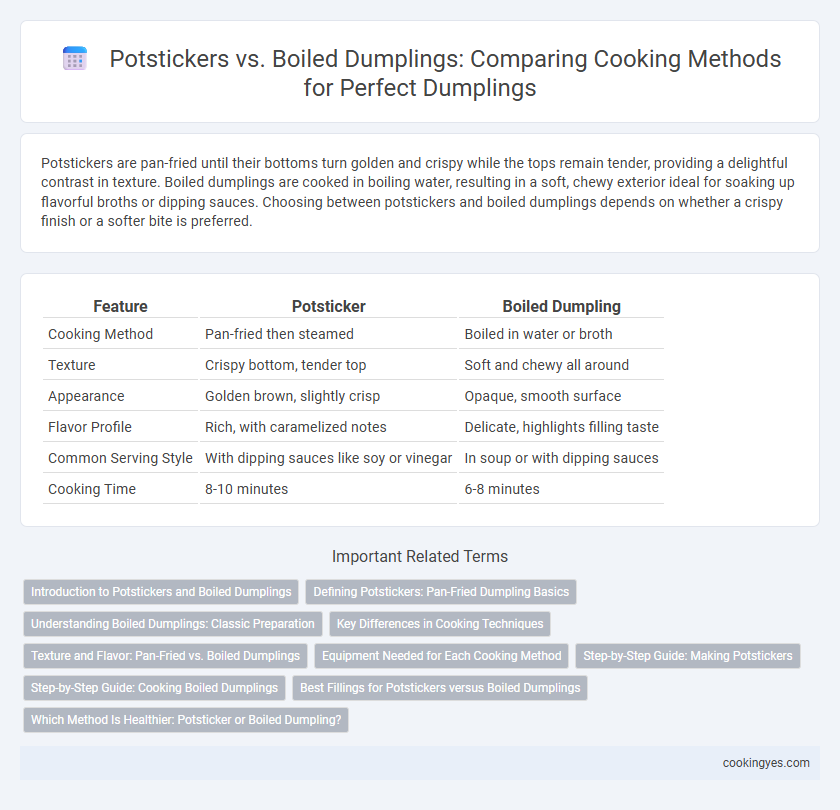Potstickers are pan-fried until their bottoms turn golden and crispy while the tops remain tender, providing a delightful contrast in texture. Boiled dumplings are cooked in boiling water, resulting in a soft, chewy exterior ideal for soaking up flavorful broths or dipping sauces. Choosing between potstickers and boiled dumplings depends on whether a crispy finish or a softer bite is preferred.
Table of Comparison
| Feature | Potsticker | Boiled Dumpling |
|---|---|---|
| Cooking Method | Pan-fried then steamed | Boiled in water or broth |
| Texture | Crispy bottom, tender top | Soft and chewy all around |
| Appearance | Golden brown, slightly crisp | Opaque, smooth surface |
| Flavor Profile | Rich, with caramelized notes | Delicate, highlights filling taste |
| Common Serving Style | With dipping sauces like soy or vinegar | In soup or with dipping sauces |
| Cooking Time | 8-10 minutes | 6-8 minutes |
Introduction to Potstickers and Boiled Dumplings
Potstickers, also known as pan-fried dumplings, are partially cooked in oil before being steamed, creating a crispy bottom layer and tender top. Boiled dumplings are cooked entirely in boiling water, resulting in a soft and chewy texture throughout. Both cooking methods highlight different textural contrasts while preserving the savory fillings typically composed of pork, vegetables, or seafood.
Defining Potstickers: Pan-Fried Dumpling Basics
Potstickers are a type of pan-fried dumpling known for their crispy, golden-brown bottom and tender, steamed top. Unlike boiled dumplings that are fully immersed in water, potstickers are cooked by first frying in oil and then steaming in a covered pan to ensure a perfect combination of texture. This cooking method enhances the flavor and provides a satisfying contrast between the crunchy exterior and juicy interior.
Understanding Boiled Dumplings: Classic Preparation
Boiled dumplings, a traditional cooking method, involve submerging dumplings in boiling water until they float, signaling they are cooked through. This technique preserves the dumpling's delicate skin and ensures a tender, juicy filling, contrasting with potstickers, which are pan-fried for a crispy bottom. Boiled dumplings are key in many Asian cuisines, prized for their soft texture and subtle flavor balance.
Key Differences in Cooking Techniques
Potstickers are pan-fried dumplings that develop a crispy bottom layer while steaming the interior to tender perfection. Boiled dumplings are fully submerged in boiling water, resulting in a soft, uniformly tender texture throughout. The key difference lies in potstickers combining frying and steaming, creating contrasting textures, while boiled dumplings emphasize delicate softness without any crispy elements.
Texture and Flavor: Pan-Fried vs. Boiled Dumplings
Pan-fried potstickers offer a crispy, golden-brown exterior with a tender, juicy filling, creating a satisfying contrast in texture. Boiled dumplings have a soft, chewy wrapper that absorbs the broth's flavor, resulting in a more delicate and moist bite. The pan-frying technique enhances savory notes through caramelization, while boiling preserves the dumpling's natural flavors and juiciness.
Equipment Needed for Each Cooking Method
Potstickers require a non-stick skillet or cast iron pan for frying, along with a lid to steam the dumplings during cooking, ensuring a crispy bottom and tender top. Boiled dumplings need a large pot filled with water or broth, as well as a slotted spoon or spider strainer to safely remove the dumplings once they float to the surface. Both methods rely on basic kitchen equipment but differ significantly in the type of cookware essential for optimal results.
Step-by-Step Guide: Making Potstickers
Potstickers require a precise cooking method starting with pan-frying dumplings in oil over medium-high heat until the bottoms are golden brown, followed by carefully adding water and covering the pan to steam them until the water evaporates. This dual cooking technique ensures a crispy bottom layer and a tender, steamed top, contrasting with boiled dumplings that are fully cooked by submerging in boiling water without frying. Mastering this step-by-step approach highlights the unique texture and flavor profile that distinguishes potstickers from traditional boiled dumplings.
Step-by-Step Guide: Cooking Boiled Dumplings
Boiled dumplings are cooked by first bringing a large pot of water to a rolling boil. Carefully drop the dumplings into the boiling water and stir gently to prevent sticking. Cook until the dumplings float to the surface and then simmer for an additional 2-3 minutes to ensure they are fully cooked through.
Best Fillings for Potstickers versus Boiled Dumplings
Potstickers, typically pan-fried to achieve a crispy bottom, are best filled with minced pork, cabbage, and ginger, which crisps well and retains flavor. Boiled dumplings excel with juicy, tender fillings like shrimp and chives or beef and scallions, as boiling preserves moisture and enhances the softness of the wrapper. Choosing the filling based on cooking method maximizes texture and taste, making pork-based mixtures ideal for potstickers and delicate seafood or beef blends perfect for boiled dumplings.
Which Method Is Healthier: Potsticker or Boiled Dumpling?
Boiled dumplings retain more nutrients and have lower fat content compared to potstickers, which require pan-frying in oil, increasing calorie count. Potstickers typically have a crispier texture due to the frying process but absorb more oil, making boiled dumplings a healthier option. Choosing boiled dumplings supports reduced fat intake and better preservation of vitamins and minerals in the filling.
Potsticker vs Boiled dumpling for cooking method Infographic

 cookingyes.com
cookingyes.com